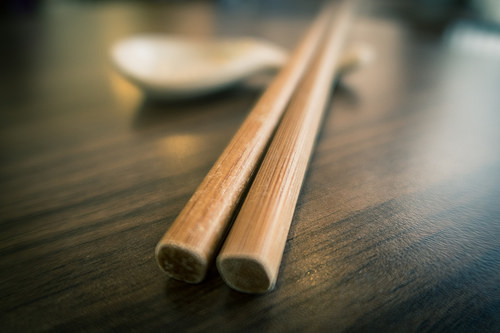
Although I have never been much of a foodie, I can’t help but enjoy the veritable plethora of Asian delicacies that my life in Hong Kong affords me. Whether it’s Korean barbecue, spicy Szechuan Chinese, fresh Japanese sushi, or Cantonese dim sum, the options are plentiful and they are mouth-wateringly delicious.
During these wonderful meals, I am often presented with a choice, one which will be familiar to any western customer who has dined in any Asian restaurant anywhere in the world: chopsticks or silverware? Do I stick to the cool, familiar comfort of stainless steel? Or do I challenge my clumsy fingers to navigate the meal with chopsticks, feebly chasing dumplings around my plate and embarrassingly dropping fish balls into my soup with a tie-ruining splatter?
I almost always go for the chopsticks. It doesn’t always go well. I’ve had embarrassing moments where a slippery siu mai escapes my weak grasp flying into my companion’s lap. Or a spicy tuna role defiantly dives back into the soy sauce creating a high sodium tsunami that wipes out anything or anyone in its path. But I appreciate the challenge and the opportunity to improve my skills. I was trained from a young age by movies like “The Karate Kid” to believe that chopsticks proficiency is an important step on the pathway to martial arts mastery.
Choosing the chopsticks in favor of the more comfortable western silverware is evidence of a “growth mindset.” Psychologist Carol S. Dweck describes this as “the passion for stretching yourself and sticking to it, even (or especially) when it’s not going well.” Those with a growth mindset enjoy putting themselves into uncomfortable situations because they know it helps them to grow and cultivate new skills.
But not everyone has this approach. Those with more of a “fixed mindset,” believe their talents and qualities are “carved in stone.”You either have it or you don’t. For them the best strategy is to stick with what they are naturally good at, thereby showing their strengths. With this mindset, there is no point in suffering the embarrassment of using chopsticks if you don’t have to.
The interesting thing about mindsets is that they become self-fulfilling prophecies. Those with a growth mindset seek opportunities that are challenging, uncomfortable and sometimes embarrassing in the short-term. And out of those opportunities they learn and grow. Those with a fixed mindset seek opportunities that showcase what they are already good at, avoiding challenging situations that might expose their weaknesses. Because of this they become even more comfortable in their status quo groove, but are less likely to grow their talents in new directions.
The research, by Dweck and others, shows that a more growth-oriented approach has its advantages. Those with a growth mindset not only open themselves to more opportunities for achievement, but they are less impacted by the minor setbacks and failures along the way. They are more resilient to stress. Creating more of a growth mindset may simply be a matter of shifting perspective:
- Embrace challenge. Don’t give up when things are getting difficult. Relish the opportunity to grow.
- Prioritize effort over talent. Rewarding your children’s academic accomplishments with the standard, “You’re so smart!” encourages a fixed mindset. An acknowledgment of their efforts, “You really worked hard on this!” or “Your efforts are really paying off!” cultivates the sense that they are not limited by inherent talents.
- Learn from criticism. Defensive reactions to criticism are also evidence of a fixed mindset. Appreciate your critics. They are helping you to grow.
Now think about the chopsticks moments in your life. Where do you believe your talents can grow, and where do you believe they are fixed? Where do you push yourself beyond your comfort zone and where do you stick to showcasing the talents that you already have? The next time you find yourself in an Asian restaurant, choose the chopsticks (and all the awkwardness that comes with them.) In the long run, you’ll be glad you did.
—
Resources and recommended reading:
Dweck, C. S. (2007). Mindset: The New Psychology of Success. Ballantine Books.
Connect with me on facebook, twitter, or pinterest.

Hi Jeremy,
Your Positive Psychology peer and my good friend of 20 years Margaret Greenberg, led me to your post! I love your post and it’s aligned with the thesis of my inspirational/ motivational book published in 2006: https://www.amazon.com/Cheaper-Than-Therapy-Create-Chopsticks/dp/1593304404/ref=asap_bc?ie=UTF8
Cheaper Than Therapy: How to Take Risks to Create the Life You Want: The Lesson of the Chopsticks
It’s a great metaphor and one that served me well when I lived in Singapore in 1992 – 1993.
Thanks again for the great post:
Gina Greenlee, author of 15 books including Cheaper Than Therapy: How to Take Risks to Create the Life You Want: The Lesson of the Chopsticks:
“The Lesson of the Chopsticks” is the second in Gina Greenlee’s series of inspirational and motivational gift books that star inanimate objects as metaphors for enhancing the way we live. This time, Gina invites us to use chopsticks to practice skills for embracing experiences that will propel us toward our best lives. Through lively illustrations, Gina guides us through the thoughts and feelings that surface when we learn how to eat with chopsticks to prepare us to seize the opportunities in life that matter most. “Cheaper Than Therapy: How to Take Risks to Create the Life You Want” is a playful yet thought-provoking catalyst for people everywhere who are ready to act on their dreams.
Thanks Gina! Great minds think alike!
Thank you for the chopstick metaphor! As adults, when we feel awkwardness or discomfort we are experiencing growing pains. Growing pains are the opposite of aging pains! As a professional in my 50’s, I am thrilled to growth as opposed to aging!